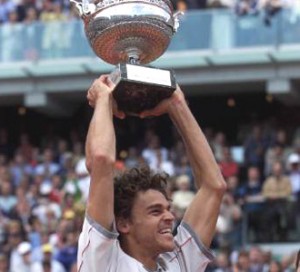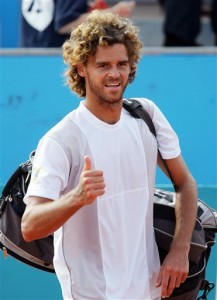Rewind 1997: Gustavo Kuerten’s Pleasant Surprise
For better or worse, the men’s tennis world lives in times of unprecedented order.
Even when there are surprises, like Rafael Nadal losing early in last year’s Roland Garros, the standard of normality was quickly picked up by Roger Federer, who has reached every Grand Slam semi since Wimbledon 2003.
This order definitely has its advantages, as Federer, Nadal, del Potro and Andy Roddick have given us some classic finals in the past few years, as opposed to watching one of the game’s greats crush a Chris Lewis or Rainer Schuettler-esque underdog in less time than it should take the players to warm up.
We may have forgotten, though, how refreshing a surprise can be.
The hottest players going into the 1997 RG were Mr. Ball Control himself, Marcelo Rios, and new flagship of the Spanish Armada Alex Corretja. The pair had faced off in two of the Masters events leading up to the game’s only clay major, with Rios easily winning the Monte Carlo final, but Corretja reversing that result in Rome.
There were also buzz surrounding Pete Sampras, never a clay-phile, but who was in the midst of one of his best seasons and had reached the semis the previous year. Thomas Muster was the ’95 champion whose clay results were waning but whose storied fitness levels still made for a fearsome prospect in a best of five match on the dirt. Gifted all-courter Yevgeny Kafelnikov was defending champion, but had been a slump almost ever since his Paris triumph.
In other words, there wasn’t any one clear favorite, but instead there were many names one could easily envision on the trophy.
It was clear from the early-goings of the event, though, that no foresight was going to be reliable. Sampras easily won his first two matches, then got food poisoning and lost to Magnus Norman in the third round. On the same day Muster clay struggles were extended, as he lost in five sets to a Brazilian player no one had ever heard of.
In the following round it even favorable for the favorites, as Rios faced Hicham Arazi in round four, a result that guaranteed a winner who was 5’9”, left-handed, and prone to unconventional shotmaking. Rios lost in that round, as did Corretja, whose elongated service toss and elaborate groundstrokes were undone in the wind and by Filip Dewulf.
Kafelnikov had shown more staying power, and in the quarters he faced Muster’s conqueror, Gustavo Kuerten. Though this Brazilian who none of us had ever heard of had shown resilience by going the distance against the not-so-amiable Austrian in round three (and then again in the following round against Andrei Medvedev), this was the first time most of us would get a good look at his game.
In the confusion following the exit of so many big names, Kuerten’s play was like having the wall torn down in a lightless room, letting in all the rays of the sun at once.
He and Kafelnikov – both of them 6’3” and slightly built – took the court in nearly identical yellow and blue Diadora clothing, but in other respects the dour Russian faced his opposite in the effervescent Kuerten. His forehand and backhand were virtually equal in terms of efficacy, but his leather whip of a one-handed backhand was definitely the more interesting stroke in terms of aesthetics. His first serve was both hard and accurate, and his remarkable speed allowed him to run down virtually everything while standing 10 feet behind the baseline.
Shining brightest of all was his disposition, as he celebrated each winner he ripped from the backcourt as if it were championship point. His smile after matches was as almost as big as his enormous mound of curly hair, and he enthusiastically waved and blew kisses to the crowd, showing an instant rapport with Parisians that would only grow as the years went by.
And with his game in flight, he routed the RG’s defending champion in the first set, 6-2. Kafelnikov leaned upon his greater experience – and his ability to hit cleaner and earlier than Kuerten – to capture the next two, but could not sustain the effort thereafter.
Kuerten won eight straight games, bageling the Russian in set four, then snatching an early break in the fifth. The 20-year-old’s youth and streamlined mass – somewhere in the neighborhood of 165 pounds – gave him endurance seemingly without limit, and he ran out the fifth set 6-4, his third five-set win in a row.
After taking four sets to stop Dewulf in the semis, the 66th-ranked Kuerten, who’d never won a pro tournament before, and had actually entered the RG with a losing record on clay, faced Sergi Bruguera in the final. The 26-year-old Spaniard had won two RGs in the early ’90s, lighting the way for his countrymen and starting a wave of Spanish success that continues to this day.
He’d hit a wall in the mid-’90s, not winning a title since 1994, but had started to find his way back in ’96 by winning the silver medal in the ’96 Olympics. At the RG, he’d won four-set victories over world No. 2 Michael Chang, the Rios-killer Arazi, and surprise semifinalist Patrick Rafter (whom more would be heard from very soon).
Against a player who had been there before, one could be forgiven for wondering if Kuerten would be overwhelmed by the occasion, and lose his loose play and free-flowing strokes.
It was an unnecessary worry. Having gotten past Dewulf, Kuerten was back in underdog mode again, and was relishing playing better-known men in front of the Parisians. Against the Spanish blockade that was Bruguera’s baseline play, Kuerten unleashed his full range of shots, and on final Sunday he showed how far clay court tennis had evolved since 1994.
He routed Bruguera 6-3, 6-4, 6-2, thus becoming the lowest-ranked Grand Slam winner since 212th-ranked Mark Edmondson won in Australia in 1976. He lifted the first trophy of his pro career, which looked as though it weighed more than he did, with his Brazil-fro covered by a backwards blue cap.
He wasn’t the most imposing champion the sport had ever seen, but he may well have been the happiest.
In the years that followed Kuerten at times struggled with knowing that he’d be the favorite on the tennis court. This led to early exits at majors over the next few years, including in the second round of the RG in 1998.
In 2000 he finally regained the RG crown by defeating Magnus Norman, then turned the year-end Masters Cup into a festa by beating Sampras and Andre Agassi in succession, finishing the year No. 1 in the world. In 2001 he won his third RG, famously using his racket to draw the shape of a heart on the clay, demonstrating his affection for Paris and its tennis fans.
But then his hip failed him, requiring surgery that would rob him of much of his court coverage. Almost as suddenly as he won his first Slam, he was forever out of contention for them. There were brilliant moments remaining for the Brazilian, most prominently his win over Federer in the third round of the RG in ’04 (the last time Federer lost before the second week of a Slam, in fact), but the last few years of his career were mostly a long goodbye.
2008 was his farewell tour, and he finished at the event where his career had come alive. After his first-round exit he stood, tears in his eyes, holding a ceremonial plate awarded to the player who had given so much to the French crowd, and had approached the sport with the joy appropriate for a man playing a game for a living.
Would that our next surprise be as pleasant as those Kuerten provided.


Hi, i just thought i’d post and let you know your blogs layout is not looking good with the Safari browser. Anyhow keep up the good work. I’ll be back for more..
If we want to get surprise through the sports. We can get more effective values through the help of sports. Most of the odious can be more effective values for the getting of good exorcise on the best quality. It will make for the good one on the same ways.